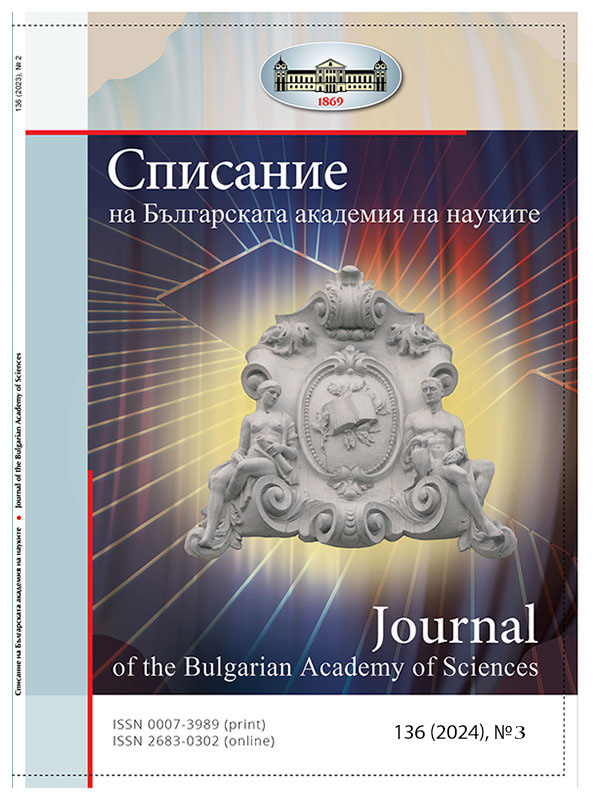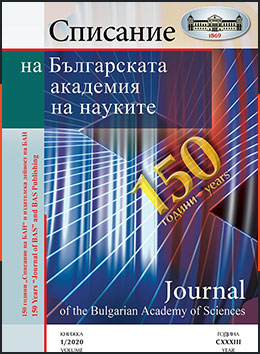Journal View
Journal of the Bulgarian Academy of Sciences
- Year: 2024
- Number: 3
- Language: Български, English
- Download Issue

- Official Celebration of the Day of the Holy Brothers Cyril and Methodius, of the Bulgarian Alphabet, Education and Culture and of Slavonic Literature
- Congratulatory Address by the President of BAS Academician Julian Revalski
-
On the Agreement of Languages Between Literature and Science in the Face of a Collapsing World
Author(s): Georgi Gospodinov
-
355 nm Surface-enhanced Raman Spectroscopy: New Horizons of Alumunium Plasmonics
Author(s): Petar A. AtanasovAbstract: The application of Raman spectroscopy has some drawbacks when investigate fluorescent molecules. The fluorescence can be depressed by using excitation in Raman spectroscopy with wavelengths in UV or DUV spectra. In this case aluminium nanostructures may play an important role in SERS of fluorescent molecules. Active Al nanostructures have been produced by us for the first time from processed AlN ceramic with nanosecond laser pulses or by direct deposition on quartz substrates using picosecond laser. The effectiveness of the Al active substrates, produced on AlN were simulated via FDTD method. The ability of using the Al active nanostructures for 355 nm SERS has been proven for the first time to study rhodamine 6G (R6G) and methylene blue (MB) as probe fluorescing molecules, as well as coconut milk.
-
The Power of Propolis – a Natural Treasure
Author(s): Vassya BankovaKeywords: propolis, plant sources, antimicrobial activity, standardozationAbstract: Honey bees (Apis mellifera L.) have thrived for millions of years, owing much of their success to their complex social structure and the diverse products they produce, including honey, beeswax, venom, propolis, pollen, and royal jelly. Propolis, also known as bee glue, plays a crucial role in hive maintenance and defense due to its antimicrobial properties. This article explores the origin, chemical composition, and pharmacological activities of propolis, shedding light on its significance in both apiculture and human health. Propolis is primarily composed of resins collected by bees from various plant sources, with its chemical composition varying based on geographical location and plant origin. Different types of propolis, such as poplar, Brazilian, Mediterranean, etc., exhibit distinct bioactive compounds, contributing to their antimicrobial, antioxidant, immunomodulatory, and antitumor properties. The antimicrobial activity of propolis has been extensively studied, showing efficacy against a wide range of bacteria, fungi, and viruses. Additionally, propolis demonstrates antioxidant effects, protecting against oxidative stress implicated in various diseases. Its immunomodulatory and antitumor properties make it a promising candidate for future therapeutic agents. Despite its potential benefits, the use of propolis in medicine is hindered by its variable composition. Efforts to standardize propolis based on its plant source and chemical profile are underway, facilitating quality control and ensuring reliable research outcomes. Looking ahead, further research is needed to explore propolis from understudied regions and its potential applications in clinical settings. Investigations into propolis formulations with improved bioavailability, such as nanoforms, hold promise for enhancing its therapeutic utility. Overall, propolis represents a valuable natural product with diverse pharmacological activities and promising prospects for future research and development.
-
Artificial Intelligence and Its Applications in Neurology
Author(s): Dimitar MaslarovKeywords: artificial intelligence, meaning, development, applications, neurologyAbstract: Artificial intelligence (AI) has emerged as a transformative force in the field of neurology, offering new avenues for understanding, diagnosing, and treating neurological disorders. This article provides an overview of the meaning, development, and applications of AI in neurology. Firstly, the concept of AI and its significance are explored. The evolution of AI technologies, from traditional rule-based systems to modern machine learning and deep learning approaches, is discussed, highlighting key milestones and breakthroughs. The article then delves into the diverse applications of AI in neurology, including stroke diagnosis, neuroimaging analysis, predictive modelling of disease progression, personalised treatment planning, and rehabilitation interventions. Additionally, ethical considerations and challenges associated with the integration of AI into clinical practice are addressed, emphasising the importance of responsible implementation and ongoing research efforts. Overall, this article aims to provide insights into the transformative potential of AI in advancing neurological care and fostering innovation in the field.
-
Proposal for New Planning Areas (NUTS 2) in Bulgaria
Author(s): Belin Mollov, Atanas KovachevAbstract: The field of the cross-cutting factor for determining the degree of participation of each member states of the EC in the use of funds for the purposes of the Cohesion policy, provides for the creation of a sustainable regional division of the country, accordingly the specificity of the nature-geographical data of the territory, the demographic trends, the historical and cultural features and the socioeconomic aspects of each one of them. For demographic and economic reasons, in 2016-2018, a process of their transformation into new districts began, but it ended in 2019 with no result. In the current study, the creation of four regions is justified: • The Danube region- unification of the North-West and North-Central regions; • The Black sea is created from the merging of the North-East and South-East planning regions, excluding the Stara Zagora region; • The districts of Blagoevgrad and Stara Zagora join the South Central Region (Thrace – Rhodope – Pirin), the “Green Heart of Europe”; • Capital region uniting four districts: Sofia, Sofia city, Pernik and Kyustendil. This change, in accordance with the requirements of Regulation (EC) No. 1059/2003 of the European Parliament, is a necessary prerequisite for a valid, logical, clear decision, responding to the needs of statistics and official practice in the EC and the eternal needs and desires of the local communities for overcoming the differences between the center and the province and the balanced development of the entire Capital Region.
-
Felix Kanitz (1829–1904)
Author(s): Vassil Zlatarski
-
The Tireless Seeker of Truth – Nikolay Rainov
Author(s): Ivan Granitski
-
Thoughts on Education: Optional
Author(s): Ivan Popchev
- In the Management Board of the Bulgarian Academy of Sciences: Re-elected Directors of Institutes
- BAS Implements Twelve Projects for Energy Efficiency of Buildings under the Recovery and Resilience Facility
- Presentation of the Book “Macedonia: History and Culture from Antiquity to Today”
- Deserved Recognition
- Pythagoras Science Prize Winners
-
The Scientist Is ahead of His Time: a Meeting with Academician Ivan Popchev
Author(s): Yordanka Zaharieva
- Corresponding Member Alek Popov
- Corresponding Member Angel Baltov
- Corresponding Member Ivan Pozharliev
Journal of BAS
ISSN 0007-3989 (print)
ISSN 2683-0302 (on line)
150 Years
"Journal of the BAS"

Sections in the Issue
In the issue you can read articles from the following sections.
